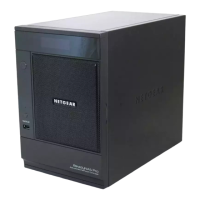
Do you have a question about the NETGEAR ReadyNAS Pro Business Edition and is the answer not in the manual?
| Model | ReadyNAS Pro Business Edition |
|---|---|
| Category | Network Storage Server |
| Form Factor | Tower |
| Drive Bays | 6 |
| Network Interfaces | 2 x Gigabit Ethernet |
| eSATA Ports | 1 |
| Operating System | ReadyNAS OS |
| Maximum Internal Raw Capacity | 12 TB |
| Memory | 1 GB DDR3 |
| RAID Support | 0, 1, 5, 6 |
| USB Ports | 3 |
| Supported Protocols | CIFS/SMB, AFP, NFS, FTP, HTTP, HTTPS, iSCSI |
| Power Supply | 250W |
Describes typographical and message formats used in the manual.
Explains how to navigate and use the manual's HTML version.
Provides instructions for printing the manual in HTML or PDF format.
Lists changes made in different versions of the manual.
Overview of the ReadyNAS Pro's purpose and capabilities for businesses.
Explains the advantages of X-RAID and X-RAID2 technologies for data management.
Details the physical features, ports, and display elements of the ReadyNAS Pro.
Provides guidelines for selecting an optimal location for the ReadyNAS Pro unit.
Guides users through the initial setup process for the ReadyNAS Pro.
Introduces the RAIDar utility for easy setup and management of ReadyNAS units.
Describes the FrontView console for managing the ReadyNAS Pro.
Information on accessing the NETGEAR ReadyNAS Community for support and resources.
Explains how to configure network interfaces, IP addresses, and other network parameters.
Guides on changing the administrator password and setting up recovery options.
Details how to manage services like CIFS, NFS, FTP, HTTP for share access.
Explains RAID technologies (Flex-RAID, X-RAID2) and volume management.
Instructions for setting up USB printers with the ReadyNAS Pro.
Covers system settings like clock, alerts, language, and firmware updates.
Describes how to back up and restore ReadyNAS configurations to preserve settings.
Explains User and Domain security modes for controlling share access.
Guides on creating and managing user and group accounts on the ReadyNAS.
Provides methods for users and administrators to change passwords.
Covers adding, managing, and deleting shares on the ReadyNAS.
Instructions for accessing shares via a web browser.
Details how to access shares using FTP and secure FTPS protocols.
Explains how to use Rsync for accessing shares, typically for backups.
Describes how to stream media to network players using UPnP AV and Home Media Server.
Guides on setting up incremental and full backup jobs for data protection.
Explains how to schedule and manage snapshots for data backup and recovery.
Details how to use the backup button to save data to a USB drive.
Options for tweaking system performance, including journaling and caching.
Connects a UPS to protect against power failures and improve system stability.
Options for disk spin-down, power timer, and wake-on-LAN.
Displays health, logs, and status of disks, fan, temperature, and UPS.
Guides on identifying, selecting, and replacing failed hard disks.
Explains how to use the system diagnostic menu for troubleshooting.
Details how to switch between RAID modes and reconfigure RAID settings.
Instructions for accessing shares from MAC OS X using AFP.
Details accessing AFP shares via Bonjour on Mac OS X.
Explains accessing AFP shares over AppleTalk on Mac.
Instructions for accessing shares from MAC OS 9.
Guides on accessing shares from Linux/Unix clients using NFS.